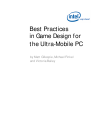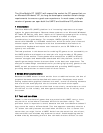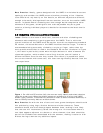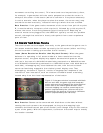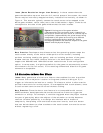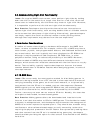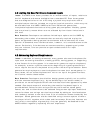4.2 Limiting the Need for Diverse Command Inputs
Issue: The UMPC form factor provides for a limited number of inputs, relative to
the full keyboard and mouse available from a standard PC. Even those games
that are designed to be run on a PC using a joystick may require the use of
multiple buttons that are included on a typical joystick controller, which may not
be available from the UMPC. UMPCs also have issues with games that
incorporate keyboard shortcuts as a key game play component. Notably, games
that are primarily mouse-driven are not affected by form-factor limitations in
this area.
Best Practice: Developers can address limited input options on the UMPC by
decreasing the number of commands that are actually required to play the
game, as opposed to being optional conveniences such as shortcuts for menu
options. A somewhat more flexible solution, however, is to create buttons on the
screen. Particularly if the buttons are context-sensitive, appearing only when
they are relevant, this can provide an open-ended solution for input
requirements.
4.3 Addressing Keyboard Requirements
Issue: In addition to issuing commands, many games also use the keyboard for
input such as naming characters, creating profiles, saving games, or supporting
a chat feature for online games. It is common for games to require a keyboard,
for example, to enter a profile name at the beginning of a gaming session but
not to require the use of a keyboard at any other time during the session. Some
games also require players to use the keyboard to name their saved games. In
many cases, the on-screen keyboard will not run on top of the game interface,
so it cannot resolve these issues.
Best Practice: Developers should either design games explicitly not to conflict
with the onscreen keyboard (e.g., by not defaulting to full-screen mode) or
provide an on-screen keyboard within the interface itself that appears only when
needed. One simple means of minimizing the need for keyboard input is to
provide default values for text strings such as profile names, saved game
names, etc. and to allow them to be selected using screen-tap input. Additional
values for these text strings can also be provided by adding an interface button
that randomly selects a new value from a list of character names created by the
developer. Saved games can also be identified using a screen capture of where
the player left off, together with a date and time stamp. Since chat features are
very rarely a core aspect of game play, they can generally be disabled on the
UMPC without negatively impacting the user experience.



